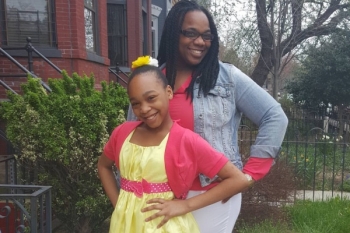On the second day of a 2016 murder trial, the decedent’s 13-year-ol daughter testified that she was sure Hairston killed her mother.
The daughter, who was 11 at the time, told the jury that she was 100 percent certain that she saw Donald Hairston pass in front of her door after allegedly killing her mother. The daughter is the only eyewitness in the case.
Hairston, 51, is charged with first-degree murder for the alleged shooting death of Stephanie Goodloe on June 18, 2016, at her home located on the 700 block of Kentucky Avenue, SE. Apparently, a motive for the killing was the fact that Hairston couldn’t control Goodloe, according to the prosecution.
During her testimony, the daughter, who was asleep in the bedroom next to her mother’s, told the jury that she was wakened by shooting noises and her mother’s screams. She said that while she lay in her bed, peaking out from the covers, she saw Hairston pass-by. “I was scared,” she said.
The girl said she believed she didn’t move for about 10 minutes because she was afraid Hairston was going to come back and kill her.
She said she recognized Hairston even though he was wearing a hoodie. She said she could see the left side of his face and noticed Hairston’s tall and wide build. She also told the jury that Hairston stopped in front of her bedroom door.
“I closed my eyes because I thought I was dreaming and when I opened them he was gone,” the daughter told an aide who works with children involved in traumatic events. According to the daughter, the shooter did not use the front door because she did not hear it open or close. The house contained three doors: a front door, back door and basement door.
However, the defense poked holes in the daughter’s testimony, questioning whether she actually saw Hairston pass in front of her door, referencing the 911 call when the daughter said, “I think it might have been my stepfather. I didn’t see anything.”
The defense also questioned the daughter’s testimony since she told the jury the murderer was wearing a gray sweatshirt and pants, but later said she didn’t actually see if he was wearing sweat pants or shorts. The defense pointed out that the daughter was most accustomed to seeing Hairston in sweat pants.
Defense attorney Lauren Johnson questioned whether the daughter was trying to make Hairston seem guilty because he moved on to caring for another family and another little girl. The daughter acknowledged that she felt jealous Hairston wasn’t paying her as much attention as he did before he started dating another woman who had a little girl.
Hairston was Abusive
According to the daughter, towards the end of Hairston and her mother’s relationship they began to argue a lot. The daughter said Hairston would threaten her mother. She also said she was sent to her room sometimes when they began arguing, but at other times left the house with her aunt.
In addition to the daughter’s testimony, a longtime friend of Goodloe testified that Hairston was physically and emotionally abusive in the months leading up to Goodloe’s death.
According to the witness, Goodloe kicked Hairston, who was 49 at the time, out of her home after the two broke up because Hairston was dating other women. Hairston stalked and harassed Goodloe, the friend said.
Johnson cited an occasion where Hairston showed up at Goodloe’s work, asking why she hadn’t answered his calls. When Goodloe explained she couldn’t answer her phone on the job, Hairston allegedly pushed her to the ground and spit in her face.
Then, about a month before the murder, Johnson said Goodloe called her after Hairston showed up at her home and asked “where the f*** have you been.” He allegedly banged on her door for several hours. The following morning, Goodloe’s tires had been slashed.
Goodloe filed a restraining order against Hairston after the incident.
Johnson is expected to be cross-examined by the defense on April 25.
Owen Meech contributed to this article



